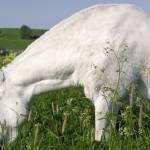Rainrot in Horses: Dietary Considerations

Wet conditions and opportunistic bacteria combine to produce rainrot, also known as rain scald, a skin infection that can wreak mayhem on a horse’s coat.
Once thought to be a sign of neglect, especially inadequate grooming, rainrot is caused by a specific pathogen that takes advantage of a compromise in skin integrity, such as an abrasion. Horses chronically affected with rainrot harbor the bacteria Dermatophilus congolensis. When lesions become moist, bacteria release zoospores, the infective stage of the bacteria, which are easily transmitted from one horse to another through flies. Because healthy skin is a resilient barrier, a compromise must occur for the bacteria to take hold. Any break in the skin or unchecked moisture can allow an infection to establish.
Characterized by grayish-white scabs, rainrot seems especially prevalent among horses with an inadequate immune system, such as those that are old, stressed, undernourished, or beset with endocrine problems like Cushing’s disease.
Coupled with management changes, such as keeping horses dry and regularly groomed, mild cases of rainrot can usually be cleared through the use of shampoos and topical treatments labeled specifically for use against rainrot. If these topical treatments do not work, a veterinary examination is warranted, as there may be an underlying health concern.
From a nutritional perspective, recurring bouts of rainrot can be a sign of imbalanced nutrition. “The immune power of a well-fortified diet is underestimated. When fed well, horses have an incredible ability to fend off attacks by everyday pathogens, including those that cause skin disease,” said Catherine Whitehouse, M.S., a nutrition advisor for Kentucky Equine Research.
Nutritional supplements can provide further protection for horses susceptible to rainrot. The advantages of biotin on hoof health is well documented, but biotin is also beneficial to the skin and coat, especially when mixed with other important nutrients. In addition to biotin, Bio-Bloom PS (Bio-Bloom HF in Australia) contains methionine, iodine, and zinc, as well as essential fatty acids, to support coat health.
Because many horses with rainrot have immunity issues, bolstering a horse’s ability to fight off infection can ward off skin conditions, Whitehouse said. The long-chain fatty acids found in EO-3, docosahexaenoic acid (DHA) and eicosapentaenoic acid (EPA), are known to strengthen immune function. The DHA and EPA found in EO-3 are derived from marine sources, which are superior to plant-derived fatty acids.








